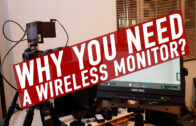Hey filmmakers Chung Dha here, I have worked on film sets where we have a video village with wireless monitors and these really help out in many ways to smoothening the workflow on set, compared to working on sets where there are none. As time is money and anything that can help you wrap up the movie faster will save you money or give you extra time to film more takes or additional angles.

The wireless rig I set up for on a recent short film was the Seetec Atem156 monitor with the Vaxis Atom500 to get a wireless signal from the Blackmagic pocket 6k, this setup we used on a indoor set as it gave us a nice large 15.6inch screen to view from. We powered the Seetec monitor with a Yinchem V-mount battery and were able to film the entire day with a single battery, but also meant we could move this monitor around on the set without having to deal with a cable connected to a wall socket for power.

And for the street scenes we use a 5 inch monitor the Feelworld F5 Pro with the Vaxis Atom500 again for the wireless feed. The great thing about this setup was that we could power the entire setup with a single Sony f970 battery, keeping the setup nice and small but also light to carry around from one location to another, but also not attract too much attention compared to the larger Seetec monitor.
So most of you will be thinking of the use as a director monitor so the director can directly see what is being filmed without needing to check the playback after every take, which will smoothen production and also lessen the time of watching playbacks. And of course as a monitor for the focus puller without needing to move with the camera to pull focus.

But there are other great uses of wireless monitors where to show the actors what their framing is, but also their blocking in the scene so they understand it easier seeing it, then trying to explain it sometimes. But also sometimes it helps showing the playback to the actors and having a moveable monitor we can have the actors stay in position to view the playback, so they can quickly do the next take, as without a wireless monitor the actors needed to walk to the camera to check the playback or the camera had to move to the actors to playback.
However it is not only useful while filming, but also before we start filming anything it is very useful, like set dressing we could already place the camera where we wanted to film, but have the production design team setup the scene and view the wireless monitor so they can see what is in the framing and also easier adjust placement of objects. Often placing something by eye or sketched in pre-production can be very different to in the camera.
And last is really for me not only as DOP, but also Gaffer lighting the scene it is much easier to check the lighting having a screen to check then having to run back and forth from the camera to see the lighting. And directing someone to move the light sometime can take longer than doing it yourself with a screen directly seeing the result.

And also it can be even used for helping with framing the camera, especially when you have the camera specially mounted in a corner or somewhere difficult to see the screen of the camera.
So spending a little more to buy or rent a monitor and wireless video transmitters and receivers can save you a lot of time on set, which could have been used to get another extra take or wrap up the shoot a day earlier and spend less money on the movie.
If you want to watch the short film that I had worked on with this wireless monitor setup ,watch the movie here below.
Hope this has helped you if you were contemplating if you should use a wireless monitor while filming your movie. If you have any questions you can ask it in the comment sections.

